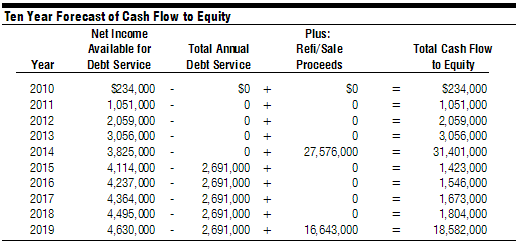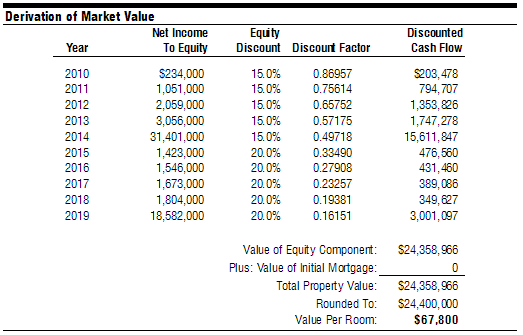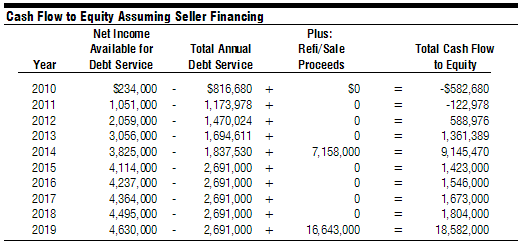
Seller financing is becoming more common in hotel real estate transactions, which is not surprising given the current dearth of third party financing. What is the impact of hotel financing upon the ultimate sales price of the hotel? As investors, lenders, brokers and appraisers look to sales transactions as an indicator of value, understanding the impact seller financing has on the value of a hotel becomes very relevant. This article addresses some of the thinking on seller financing and illustrates its impact on value in a hypothetical case study.
In determining market value via the sales comparison approach, if one is analyzing a sale with seller financing the sales price must be adjusted to reflect what the price would been if the transaction had been all cash to the seller. In a well functioning marketplace, third party debt is typically obtained by the buyer to finance an acquisition and the seller receives the full proceeds in cash to pay off any existing debt and generate a return on equity. In markets where third party mortgage financing is difficult to obtain, seller financing becomes more prevalent. When do prices achieved in transactions that are financed with a purchase money mortgage (seller financing) become reflective of market value? It is generally accepted that when seller finance becomes more the norm than not, then the prices achieved can be considered “at market”, and thus may not require an adjustment if the terms of the financing are fairly typical. At the current time many lenders/owners are weighing the impact of seller financing, and are choosing to garner a higher sales price by providing a mortgage to the buyer.
Seller financing provides many benefits to both the buyer and the seller of a hotel asset. The primary benefit in the current market where third party financing is virtually unavailable is that seller financing enables a transaction to take place. Without seller financing many hotels would sell for lower prices and may not be able to be sold at all. The lender does not have to retain the risk of hotel ownership and can pass the asset on to a newly energized buyer with new capital to cover any operating shortfalls or required capital expenditures, enabling the hotel to return to health. The buyer can leverage its equity investment, increasing the yield to its equity investors and allowing for more acquisitions through the conservation of capital. Best of all, seller financing takes away the uncertainty of obtaining financing to consummate a sales transaction – there is no need for buyer financing contingencies.
The additional benefits of seller financing include higher leverage than that which would be available through a third party lender, and likely a more favorable interest rate as well. Some of the seller financing we have been asked to analyze provide for fixed-rate, interest only mortgages based on the very favorable low interest rate in the original CMBS loan. Others provide for a floating rate tied to Libor. Securing debt capital that requires only a 6% to 7% rate of return to replace equity capital requiring yields in the mid-teens to low-20’s is a significant value enhancer. Perhaps the more valuable benefit of seller financing is the higher leverage – from 50% to 90%, that may be available.
The term of a seller financed loan is also a key factor to consider. Brokers with whom we discussed this topic indicated that a one or two year loan will not provide buyers with much comfort, as they will be faced with finding a replacement mortgage before the property’s net income is recovered and most likely before a fully functioning debt market has resumed. Three year terms are fairly typical, though sellers often provide for a two year extension so that the buyer is assured a full five years to turn around the property and to arrange for a new replacement mortgage. The extension may provide for an interest rate that is stepped up or marked to market at that time.
Seller financing does not only enhance value by providing for a lower cost of capital, it also widens the universe of potential purchasers to include not only those that have the wherewithal to pay all cash, but also those that have more limited equity and require financing. The larger the number of parties bidding on an asset, the higher the ultimate price that will likely be paid. Seller financing becomes more of a factor the greater the dollar amount of the transaction. Seller financing is not that impactful for purchase prices less than $10 million, particularly when SBA 504 or other programs are available. For very large transactions, seller financing may be the only way for any buyers to consummate for a purchase. Of course by providing seller financing a lender does not get to remove the loan from its books, and also continues to carry the burden of monitoring the loan and getting repaid. But the mortgage becomes more marketable because it is more appropriately sized for the net income and value of the property, thus reducing risk of full repayment.
Over the past year our lender clients are have been frequently asking for our opinion of the value of a hotel two scenarios assuming: 1) market rate financing (market value) and 2) that the asset would sell with financing provided by the lender/owner who is disposing of the asset. In order to gauge the impact of seller financing upon a typical hotel transaction we present an example of an actual hotel that we recently appraised. The first step in our case study is to estimate the market value of the subject 360 room hotel assuming current market rate financing. The hotel is suffering from greatly depressed income levels. After generating roundly $4 million in NOI in 2008, the hotel’s net income declined to just over $200,000 in 2009. We forecast net operating income to recovery over a five year period, once again reaching roundly $4 million by 2014.
The property’s market value, based on a 10-year, mortgage equity discounted cash flow analysis, is concluded to be $24,400,000 or $67,800 per room. 1Developing this estimate of market value requires several steps, discussed here. Because the hotel’s net income is so depressed, it would be difficult if not impossible to obtain a traditional first mortgage in today’s market. Thus, for the purpose of estimating market value it is assumed that the buyer would pay all cash initially, with a refinancing sometime in the future when debt becomes more readily available. Given the risk of refinancing, as well as the characteristics of the subject’s market, which will require a long recovery, we assume that the property will be refinanced at the end of the fifth projection year, once net income has returned to pre-financial crisis levels. A 15% initial yield requirement for the all cash purchase has been assumed in our analysis – this rate reflects the significantly lower risk of having no debt service burden, and is based on our discussions with investors currently active in the market.
The hotel is valued at the time of the refinancing, assumed to be 2014, at roundly a 10% capitalization rate applied to the hotel’s stabilized year’s net income. A 70% loan-to-value ratio is considered reasonable to anticipate upon refinancing at the end of the fifth year. Once the hotel is leveraged, the equity yield is projected to increase to 20% to reflect the additional risk of a debt service burden. The derivation of the refinancing proceeds at the end of the fifth projection year is presented in the following chart.

The net income to equity for the five years following the refinancing is raised to 20% to reflect the significant additional risk of having to pay debt service before receiving any return on equity.
The net proceeds to equity at the end of the ten year projection period is calculated by capitalizing the 11th year’s net income by a terminal capitalization rate of 11%. The outstanding mortgage balance at that time and brokerage/legal expenses are deducted to derive the reversion to equity.

The cash flow to equity over the ten year projection period, including refinancing and sales proceeds, is presented below. Note that no debt service is paid during first five years of ownership, based on an initial all cash transaction.

The cash flow to equity is then discounted at the required equity yield rates: 15% for the first five years of an all cash acquisition and 20% for the last five years, subsequent to the refinancing. The sum of the discounted cash flow equates to a value of $24,400,000 or $67,800 a room, as illustrated below. Note that there is no mortgage balance to add to the discounted cash flow because an all cash purchase is assumed upon sale as of the date of value.

The overall weighted cost of capital or unlevered discount rate can be computed based on this value by solving for the internal rate of return that equates the net income before debt service to the estimate of market value, as set forth below.

Now let’s see what impact seller financing has on the value of the property. In this case the seller/owner is willing to provide a 70% loan based on the value that is derived under this scenario, which creates a circular argument that can be solved for through an iterative process. The debt is calculated at 70%of the value that we conclude through this exercise.

The debt is priced at a spread over Libor that steps up each year through the five year term of the loan. Based on a forecast of Libor, the projected interest rate is set forth below.

The refinancing proceeds after paying off the purchase money mortgage at the end of the fifth projection year is calculated as follows, based on the fifth year value previously derived in our market value estimate:

A sale of the asset is assumed at the end of the 10th year, with the same reversionary value set forth in the derivation of market value. The cash flow to equity with the debt service deductions in the early years based on seller financing is set forth below, concluding in an estimate of value assuming seller financing.

The value assuming seller financing is derived by discounting the cash flow to equity at the required equity yield rate of 20%, presented as follows:

The difference between the market value estimate of $67,800 per room and the value assuming seller financing of $81,000 is roundly 20%. Brokers and buyers interviewed for this article uniformly indicated that the typical value enhancement in the current market falls in the range of 20%, varying, of course, with the terms of the deal. From the numerous appraisals we have been performing that assume seller financing, the terms presented in this case study are pretty typical.
The overall weighted cost of capital or unlevered discount rate can be computed by solving for the internal rate of return that equates the cash flow before debt service to the value, as set forth below.

Note that the discount rate has declined from 14.6% in our market value derivation to 12.0% in the scenario assuming seller financing for the first five years, a significant 260 point spread.
As would be expected, the percentage gain in value due the seller financing rises with the amount of leverage provided, as indicated in the following matrix:

In summary, seller financing is becoming more prevalent in today’s marketplace, playing a valuable role in the consummation of hotel transactions. Both buyers and sellers benefit from the availability of this source of capital in the current market. A widening of the universe of potential investors creates competition, which in turn favorably impacts an asset’s ultimate disposition price. The terms of most seller financing today enhances a hotel’s value by +/- 20%, according to brokers we interviewed. Market participants who gauge value trends through hotel sales transactions should be careful to take into consideration the impact of seller financing upon reported sales prices. Seller financing may become the norm over the next year or two as sales activity picks up, at which time no adjustment to reflect market value may be necessary – only time will tell how the current cycle will play out.
1 A ten year horizon is selected because it enables investors to compare yields over the commonly accepted ten year period used for analytical purposes – it does not necessarily reflect an assumed holding period. Internal rates of return generated by other real estate investments, such as retail shopping centers and office buildings are typically analyzed over a ten year period to allow for a complete tenant turnover to market rent as leases expire.

This is a very good artical. I would like to know one thing if you can help me here. How do you know what should be the right price or how to determine the right price for the property? Thank you Respectfully Ravi Sudan
Ravi, When we value hotels we try and reflect the prices being paid for assets in the market. We investigate the property's condition, market conditions, new supply, the property's income and expense statemetns and then we prepare a forecast of what we think the property will generate in terms of net operating income going forward. We then apply the approach set forth in my article for estimating value - it is based on the amount of debt available, the terms of the debt and equity investor return requirements. I hope this is of some assistance to you. Kind regards, Suzanne
Suzanne...What a nicely written and timely article. Well researched. Organized and presented in an easily understood fashion. Thanks for doing this and sharing with the rest of us your expertise.
Bob, Thank you for your nice comments. The conversation I had with you regarding seller financing was very helpful to me in putting this together - I always appreciate the time you take to talk to me. I hope things are going well for you and that your conference is a success this year. Warmest regards, Suzanne
Hi Suzanne, Thank you for this very timely and relevant article. Once again, you clearly articulate complexities in the current market that affect a broad array of market participants. Thank you for sharing your expertise, and kudos to everyone on your team who contributed to the outstanding research and analysis for this article. Best regards, Jordan
Hi Jordan, Thanks so much for our kind comments. I hope everything is going well for you these days - I appreciate your staying in touch, Best regards, Suzanne